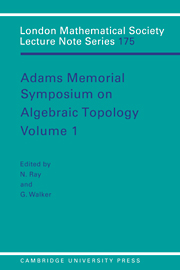Book contents
- Frontmatter
- Contents
- Preface
- Contents of Volume 2
- 1 The work of J. F. Adams
- 2 Twisted tensor products of DGA's and the Adams-Hilton model for the total space of a fibration
- 3 Hochschild homology, cyclic homology and the cobar construction
- 4 Hermitian A∞ rings and their K-theory
- 5 A splitting result for the second homology group of the general linear group
- 6 Low dimensional spinor representations, Adams maps and geometric dimension
- 7 The characteristic classes for the exceptional Lie groups
- 8 How can you tell two spaces apart when they have the same n-type for all n?
- 9 A generalized Grothendieck spectral sequence
- 10 Localization of the homotopy set of the axes of pairings
- 11 Fibrewise reduced product spaces
- 12 Computing homotopy types using crossed n-cubes of groups
- 13 On orthogonal pairs in categories and localization
- 14 A note on extensions of nilpotent groups
- 15 On the Swan subgroup of metacyclic groups
- 16 Fields of spaces
- 17 Maps between p-completed classifying spaces, III
- 18 Retracts of classifying spaces
- 19 On the dimension theory of dominant summands
12 - Computing homotopy types using crossed n-cubes of groups
Published online by Cambridge University Press: 29 January 2010
- Frontmatter
- Contents
- Preface
- Contents of Volume 2
- 1 The work of J. F. Adams
- 2 Twisted tensor products of DGA's and the Adams-Hilton model for the total space of a fibration
- 3 Hochschild homology, cyclic homology and the cobar construction
- 4 Hermitian A∞ rings and their K-theory
- 5 A splitting result for the second homology group of the general linear group
- 6 Low dimensional spinor representations, Adams maps and geometric dimension
- 7 The characteristic classes for the exceptional Lie groups
- 8 How can you tell two spaces apart when they have the same n-type for all n?
- 9 A generalized Grothendieck spectral sequence
- 10 Localization of the homotopy set of the axes of pairings
- 11 Fibrewise reduced product spaces
- 12 Computing homotopy types using crossed n-cubes of groups
- 13 On orthogonal pairs in categories and localization
- 14 A note on extensions of nilpotent groups
- 15 On the Swan subgroup of metacyclic groups
- 16 Fields of spaces
- 17 Maps between p-completed classifying spaces, III
- 18 Retracts of classifying spaces
- 19 On the dimension theory of dominant summands
Summary
The aim of this paper is to explain how, through the work of a number of people, some algebraic structures related to groupoids have yielded algebraic descriptions of homotopy n-types. Further, these descriptions are explicit, and in some cases completely computable, in a way not possible with the traditional Postnikov systems, or with other models, such as simplicial groups.
These algebraic structures take into account the action of the fundamental group. It follows that the algebra has to be at least as complicated as that of groups, and the basic facts on the use of the fundamental group in 1-dimensional homotopy theory are recalled in Section 1. It is reasonable to suppose that it is these facts that a higher dimensional theory should imitate.
However, modern methods in homotopy theory have generally concentrated on methods as far away from those for the fundamental group as possible. Such a concentration has its limitations, since many problems in the applications of homotopy theory require a non-trivial fundamental group (low dimensional topology, homology of groups, algebraic K-theory, group actions, …). We believe that the methods outlined here continue a classical tradition of algebraic topology. Certainly, in this theory non- Abelian groups have a clear role, and the structures which appear arise directly from the geometry, as algebraic structures on sets of homotopy classes.
It is interesting that this higher dimensional theory emerges not directly from groups, but from groupoids.
- Type
- Chapter
- Information
- Adams Memorial Symposium on Algebraic Topology , pp. 187 - 210Publisher: Cambridge University PressPrint publication year: 1992
- 3
- Cited by



